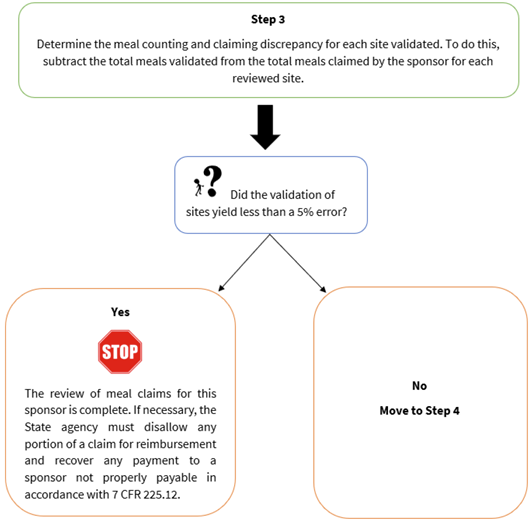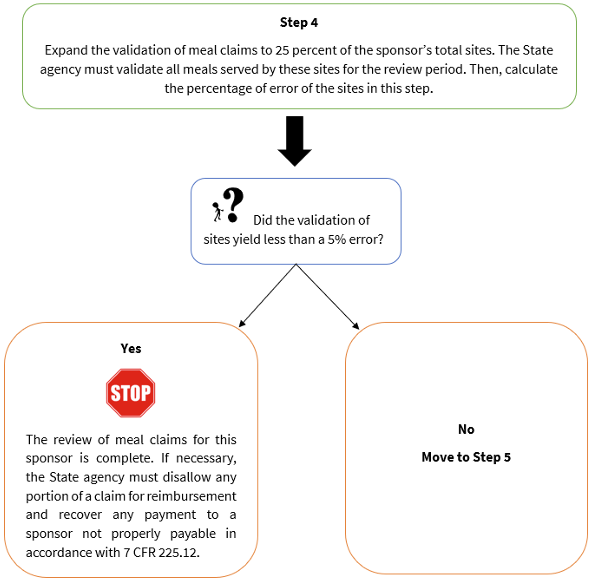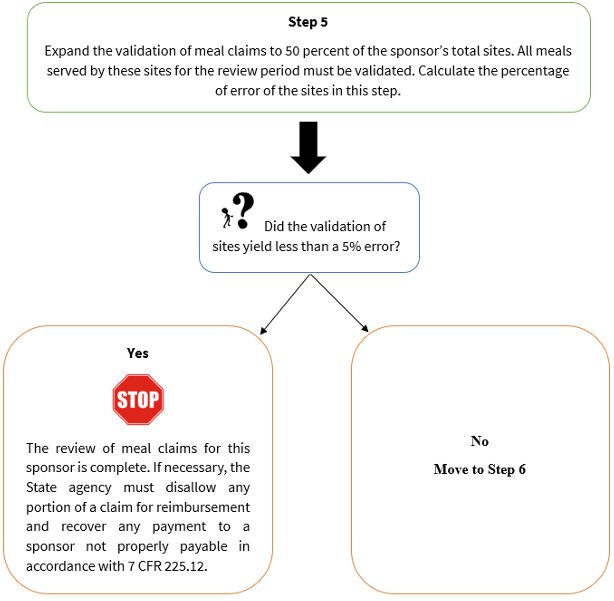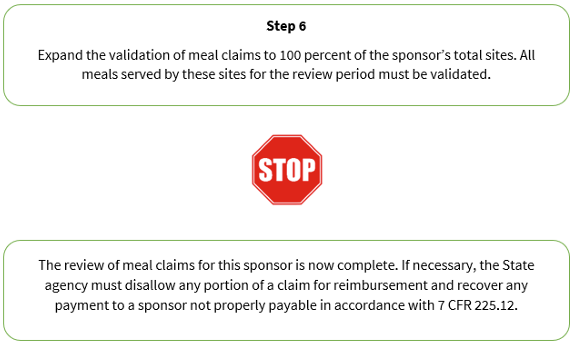Meal Claim Validation in the Summer Food Service Program
April 19, 2024

The SFSP Streamlining Final rule established a process that State agencies must follow to validate SFSP sponsor meal claims during the sponsor review. The meal claim validation process utilizes a streamlined record review process outlined at 7 CFR 225.7(e)(6)(i). The step-by-step process is outlined below.
Why It Matters
State agencies that administer SFSP are responsible for reviewing sponsors and sites to ensure compliance with Program regulations. In order to decrease the burden on State agencies, the meal claim validation process has been streamlined.
Meal Claim Validation Process
1. Site Selection
The State agency must first select a sample of sites to review for each sponsor under review. The State agency must review meal claims from at least 10 percent of each reviewed sponsor's sites, or one site, whichever number is greater, per 7 CFR 225.7(e)(4)(v). Under this new streamlined process, State agencies are no longer required to validate 100 percent of meal claims for all of the reviewed sponsor’s sites. The selected sample of sites for the meal claim validation should best reflect the sponsor’s entire population of sites by including characteristics outlined at 7 CFR 225.7(e)(5). Characteristics include:
- The maximum number of meals approved to be served; • Method of obtaining meals (i.e., self-prep or vended);
- Time since last review by the State agency
- Type of site (e.g., open, closed enrolled, camp);
- Type of physical location (e.g., school, outdoor area, community center);
- Rural designation (i.e., rural, or non-rural);
- Meal service type (congregate or non-congregate)
- If non-congregate, meal distribution method (e.g., meal pick-up, delivery); and
- Affiliation with the sponsor.
The State agency may also use additional criteria to select sites to include findings from other audits or reviews, potential error in daily meal counts, or sites recommended by the sponsor.
2. Document Review and Comparison
Each State agency must develop a document review process for meal claim validation, per 7 CFR 225.7(e)(6)(i). At a minimum, the State agency must reconcile delivery receipts and daily meal counts from the selected sites. Other records such as the menus, site information sheets, production records and purchasing invoices may be used to validate a meal claim in addition to the delivery receipts and meal count forms, and may be especially helpful when reviewing self-preparation meal sites These documents will provide the State agency with information such as:
- What food components were served,
- Estimated number of daily meals,
- Types of meals served,
- Information to support the minimum required serving size and any details of the food or supplies purchased, as well as the date and the amount purchased.
All meals served by the selected sites for the review period must be validated. These documents must then be compared to the sponsor’s claim consolidation spreadsheet to include the meals claimed for reimbursement by the sponsor for the period under review. The State agency must then calculate the percentage of error for each of the sites.
For example, site ABC is selected as part of the meal claim validation process during a sponsor review. Site ABC claims to have served 100 lunch meals on a Tuesday during the period of review which included a menu item of breaded chicken nuggets. First, the State agency reviewer would confirm that at least 100 meals were delivered to site ABC on Tuesday by reviewing the delivery receipts and comparing these to the meal claim for that day and that meal service. If the reviewer finds that only 80 meals were delivered to the site for this particular meal service, then there are 20 meals that were claimed in error. The reviewer would need to calculate the percentage of error, described below.
The State agency must, at a minimum, reconcile the delivery receipts and the daily meal count form. The State agency reviewer may also use additional records such as the menu for that particular meal service to confirm that chicken nuggets were served to satisfy the meat/meat alternate component at site ABC. The reviewer may also evaluate production records to ensure enough breaded chicken nuggets were prepared for 100 lunch meals.
3. Error Calculation and Meal Disallowance
Next, the State agency must establish the meal counting and claiming discrepancy for each selected site and determine the total percentage of error. The validation of each site must yield less than a five percent total percentage of error. This is calculated by adding together all discrepancies, including overclaims and underclaims, and dividing this total by the total meals claimed by the sponsor for all reviewed sites within the validation sample (see example in Attachment 2). If the validation yields more than a five percent total percentage of error, the meal claim validation must be expanded per the instructions in 7 CFR 225.7(e)(6)(v) (also see Attachment 1).
When the validation of sites yields less than a five percent error, the review of meal claims for the sponsor is complete.
The State agency must then disallow any portion of the claim for reimbursement and recover any payment to a sponsor not properly payable in accordance with 7 CFR 225.12. Claims for reimbursement are not properly payable if a sponsor’s records do not support all meals claimed. It is also the responsibility of the State agency to notify the sponsor of the reasons for any disallowance or demand for repayment. State agencies may also disregard overpayment which does not exceed $100 or does not exceed the amount established by State law, regulations, or procedures as a minimum for which claims will be made for State losses generally per 7 CFR 225.10(c). If there is substantial evidence of violation of criminal law or civil fraud statutes, the State agency may not disregard overpayments. Additionally, if there is reason to believe that the sponsor has engaged in unlawful acts related to Program operations, the State agency has the discretion to expand the meal claim validation beyond the review period or include additional sites per 7 CFR 225.7(e)(6)(vi).
Meal Claim Validation Flow chart (Attachment 1)





Meal Claim Validation Example (Attachment 2)
Sponsor A has a total of 35 SFSP sites. Per Program regulations at 7 CFR 225.7(e)(4)(v), at least 10 percent of Sponsor A’s sites must be reviewed during the review process. The State agency calculates the sample size required for the initial validation by multiplying the total number of sites (35) by 10 percent (.10), which equates to 3.5; after rounding up (per 7 CFR 225.7(e)(6)(iii)), the number of sites required to be reviewed is 4. Using the process outlined in Attachment 1 and at 7 CFR 225.7(e)(6)(iv), the State agency must validate all meals served by these four sites during the month of review and calculate the percentage of error.
1. First, the State agency must determine the meal counting and claiming discrepancy for each site validated. To do this, subtract the total meals validated from the total meals claimed by the sponsor for each reviewed site as shown in Table A. For example, for Site #1, the total meals validated is 260 and the total meals claimed is 300.
Calculation of discrepancy: 300 - 260 = 40
Therefore, the meal count discrepancy for Site #1 is 40. The State agency will then follow this step for each of the other sites being validated. Below, Table A lists the calculations completed for each of the four sites.
2. Next, determine the absolute value of each discrepancy for each site. The numbers for absolute value are expressed as positive numbers for both overclaims and underclaims. See the column in Table A below labeled Absolute Value. The absolute values for each site are as follows:
-
- Site #1 is 40
- Site #2 is 25*
- Site #3 is 5
- Site #4 is 0
*Note: the meal count discrepancy for Site #2 is (-25), the absolute value is expressed as a positive number, resulting in an underclaim of 25 meals at this site.
- The next step is to calculate the total discrepancy by adding together all discrepancies from each site reviewed. Add the absolute value for each discrepancy for each of the sponsor’s sites #1, 2, 3, and 4. The total is 70.
- Now, calculate the percent error. Divide the total discrepancies by the total meals claimed by the sponsor for all reviewed sites within the validation sample and then multiply by 100 to calculate the percentage of error. The total meals claimed for the validation sample is 650 meals.
Calculation of percent error: 70 ÷ 650 = 0.1076 and then, 0.1076 × 100 = 10.76%
Fractions must be rounded up (≥0.5) or down (<0.5) to the nearest whole number. The percent error for Step 1 in the meal claim validation process is 11%, which is above the allowed percent error of 5 percent.
Table A

Any validation yielding an error rate of five percent or more requires the State agency to expand the validation of meal claims. The State agency will need to move to Step 4 in Attachment 1 per 7 CFR 225.7(e)(6)(iv) and increase the validation to 25 percent of the sponsor’s total sites.
- In order to satisfy this requirement, the State agency only needs to review the additional number of sites in the expanded sample. To determine the sample size required in the next step of validation, the State agency multiplies 35 by .25, which equates to 8.75. After rounding up, the number of sites to be reviewed is 9. To reach 25 percent of the total number of sites, or 9 sites, the State agency would only need to validate 5 additional sites (9 minus the 4 sites validated in Step 1).
- The State agency then calculates the percent error for a total of 9 sites, and if the error is five percent or more, the State agency will need to move to Step 5 and expand the validation to 50 percent of the sponsor’s total sites, which in this example is a total of 18 sites and recalculate the percent error.
After completing Step 5 from Attachment 1, if the validation of sites yields a five percent error or more, the validation of meal claims must expand to 100 percent of the sponsor’s total sites, as described in Step 6. If the validation of sites at any step in the meal claim validation yields less than a five percent error, the review of meal claims is complete.
Read the full guidance: Meal Claim Validation in the Summer Food Service Program (SFSP 09-2024).
